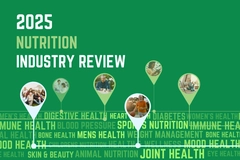
- Industry news
Industry news
- Category news
- Reports
- Key trends
- Multimedia
Multimedia
- Journal
- Events
- Suppliers
Suppliers
- Home
- Industry news
Industry news
- Category news
- Reports
- Key trends
- Multimedia
Multimedia
- Events
- Suppliers
Suppliers
Rousselot Innovation Days: Spotlight on collagen peptides research advances

Rousselot highlighted its research and formulation advances in collagen at its Innovation Days. The nutrition provider aims to deepen its understanding on collagen’s impact when science unlocks new targeted health benefits.
Nutrition Insight attended the event in Gent, Belgium, where the company’s science and innovation experts explored how Rousselot’s Nextida collagen peptides impact blood glucose, insulin, and GLP-1 hormones, while explaining how collagen’s composition influences its associated health benefits.
Jeroen Colpaert, executive vice president of Rousselot, says the company aims to empower people to lead healthier lives through science-backed nutrition, food, and pharmaceutical solutions.
“Innovation at Rousselot is about opening new growth areas, pioneering, and setting the tone in the collagen industry, which is transforming from ‘collagen good for all’ to ‘collagen good for you,’” he details. “We’ve named this next generation of collagen peptides ‘Nextida’ — the next wave of collagen.”
Randall C. Stuewe, chairman and CEO of Darling Ingredients, which owns Rousselot, comments that it “makes absolute sense” that food and health are connected.
“America is waking up to that with the highest health care costs in the world today, and they’re saying, ‘if we just cleaned up our food supply, took out synthetic dyes and preservatives, and ate a little fresher, maybe the health care costs would go down.’”
“We have a dream and an obligation to provide the world with a cleaner, safer food supply,” he adds. “Functional ingredients like collagen peptides are an opportunity.”
Collagen peptides in GLP-1
Dr. Catarina Silva, science integration manager at Rousselot, explains that people produce GLP-1 and GIP (gastric inhibitory polypeptide) hormones as “project managers” to handle food and ensure nutrients end up where they need to be.
“When you eat, you produce GLP-1 and GIP, which tell your pancreas to produce insulin. It will tell your stomach to slow down, so it makes you feel full, you eat less, and you lower your glucose spike.”
Although glucose is a great fuel for the body, she cautions that when left alone, it can wreak havoc and attach to proteins, like collagen, contributing to aging processes.
 Jeroen Colpaert, executive vice president of Rousselot.“We know nutrition can help us produce our own GLP-1. So the science lab asked: ‘Can we use collagen to do what we already can, but better? And if so, is there a specific collagen composition that performs better than all the others?’”
Jeroen Colpaert, executive vice president of Rousselot.“We know nutrition can help us produce our own GLP-1. So the science lab asked: ‘Can we use collagen to do what we already can, but better? And if so, is there a specific collagen composition that performs better than all the others?’”
The company’s Nextida platform collects all the information within the collagen molecule. “This molecule is a gigantic warehouse of information, and by using different processes, we can extract that information,” details Silva.
The Rousselot science team cut the collagen molecule in different ways and tested the resulting peptides on intestinal cells that secrete GLP-1, resulting in one candidate with the best results.
“We decided to test this in a simple clinical trial,” adds Silva. “We gave 5 g or 10 g of Nextida GC, or a placebo, 30 minutes before a breakfast of bread, jam, and butter.”
“The trial showed that taking Nextida GC before a meal helps boost the natural GLP-1 and GIP secretion, and the glucose spike is lowered by 42%. This was achieved without overshooting insulin, which indicates an improved insulin response.”
Nextida GC challenge
Florencia Moreno-Torres, the company’s global business development and marketing manager, details how Rousselot challenged its team members to integrate Nextida GC into their daily routine.
“We would take 10 g of Nextida GC before a selected meal, use a CGM (continuous glucose monitor) connected to a smartphone to track blood glucose levels, and use a survey to track eating patterns and rate satiety and appetite. We did this for 14 days.”
“We wanted to show how real-world experience meets clinical science,” she explains. “We paired these testimonials and empirical evidence with results of our clinical trial, a gold-standard double-blind, placebo-controlled, crossover clinical study.”
The challenge resulted in three personas, or consumer profiles: the Energy Crasher, Athlete, and Glucose Conscious.
The Energy Crasher is semi-active, a new mom in a busy house with a long commute and poor sleep quality. Without Nextida GC, glucose levels look like a roller coaster with high glucose spikes and deep crashes.
However, with the collagen peptide, that glucose spike was almost nonexistent. Moreno-Torres says Rousselot’s clinical trial supports these results.
The Athlete, on a healthy diet and elite training program, also had higher glucose spikes on non-Nextida GC days. When taking the collagen peptides before a meal, satiety levels increased, and body weight was reduced.
 Dr. Catarina Silva and Florencia Moreno-Torres detail how specific collagen peptides for metabolic health can leverage GLP-1 hormones.The third persona, the Glucose Conscious, has a sedentary lifestyle and mainly has food cravings in the evening when the body is less efficient at processing glucose.
Dr. Catarina Silva and Florencia Moreno-Torres detail how specific collagen peptides for metabolic health can leverage GLP-1 hormones.The third persona, the Glucose Conscious, has a sedentary lifestyle and mainly has food cravings in the evening when the body is less efficient at processing glucose.
The clinical trial showed that participants taking 5 or 10 g of Nextida GC 30 minutes before a meal reported slightly increased insulin levels. After the meal, insulin levels were lower than when taking the placebo.
“We were excited about this because it shows you have an improved insulin response,” says Silva.
Beyond glucose management
Although Nextida GC helps glucose control, which is what GC stands for, Moreno-Torres notes it can benefit many other areas. “We think about Nextida GC as a strategic ally for metabolic wellness.”
“Think about energy optimization, fatigue, being able to support a weight loss journey, improving sleeping habits, feeling less stressed, and improving mood — overall supporting a more balanced lifestyle.”
She adds that Nextida GC is also a versatile ingredient that can be used in powders, ready-to-drink products, shots, gels, and premium snacks. It can be used across different consumer segments and ages.
Silva summarizes: “With a very low dosage of Nextida GC, you can boost GLP-1 and GIP, reduce your glucose spikes to improve your energy levels, and improve your insulin response, which is important in a world where we can eat all the time and most of our food is not that healthy.”
Power of hydroxyproline
Dr. Bjorn Vergauwen, scientific director at Rousselot, highlights the importance of hydroxyproline in collagen, which accounts for around 10% of the protein by weight. “Hydroxyproline makes collagen unique; because of that, it’s essential for life and health.”
“Hydroxyproline is a derivative of the amino acid proline,” he explains. “An enzyme puts a water derivative (a hydroxyl group) on proline, which is called hydroxylation. Importantly, this enzyme requires vitamin C.”
This compound makes collagen strong, enables it to interact with cell biology, and provides bioactivity to the protein.
Although Rousselot is tracking new initiatives, the company cautions that precision fermentation currently cannot produce collagen with hydroxyproline.“Collagen is only strong with hydroxyproline,” details Vergauwen. “The protein consists of three strands that are twisted together into a flexible and strong structure. But it requires the correct hydroxylation of collagen to form a collagen triple helix and fibers.”
A recent experiment from Gent University, Belgium, finds that hydroxyproline is essential to ensure collagen interacts with cells. “Hydroxyproline in collagen engages with cell receptors so that certain biological processes can happen, such as blood coagulation, immunity, and wound healing.”
“The third striking characteristic of collagen is that it confers health benefits upon oral ingestion, and hydroxyproline is responsible for that,” Vergauwen says. “Many scientific articles show collagen peptides are bioactive because hydroxyproline-containing peptides are absorbed in the body.”
Challenge of “true” collagen
At the Innovation Days, Vergauwen also explored the potential of precision fermentation to produce collagen without animal sources.
“With precision fermentation, virtually any protein can be produced in a microbe just by copy-pasting its DNA into the genome of that microbe. Precision fermentation has been successful for proteins like milk, pea, and artificial sweetener proteins, and collagen has also been produced by recombinant means.”
However, he cautions that analysis of recombinant or GMO collagen products on the market shows that they lack hydroxyproline, therefore, these cannot be considered “true collagen.”
“Without hydroxyproline, collagen cannot be strong, cannot interact properly with human biology, and cannot have most of the bioactivity within collagen.”
Vergauwen explains that collagen biosynthesis requires over 12 steps and 30 proteins, including four for hydroxylation. All these proteins are exclusively animal. “Although microbes can make a single protein, producing multiple proteins at the same time is much more difficult.”
Rousselot recognizes the potential of precision fermentation, but also acknowledges significant challenges, particularly in regulation and large-scale production.
“We therefore do not consider it a direct one-to-one replacement for natural collagen, which offers unique properties that cannot be replicated.” Vergauwen concludes.











